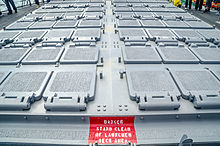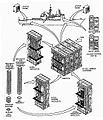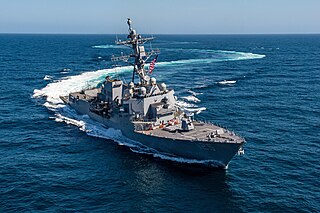
The Arleigh Burke class of guided-missile destroyers (DDGs) is a United States Navy class of destroyer centered around the Aegis Combat System and the SPY-1D multi-function passive electronically scanned array radar. The class is named for Admiral Arleigh Burke, an American destroyer officer in World War II and later Chief of Naval Operations. With an overall length of 505 to 509.5 feet, displacement ranging from 8,300 to 9,700 tons, and weaponry including over 90 missiles, the Arleigh Burke-class destroyers are larger and more heavily armed than many previous classes of guided-missile cruisers.
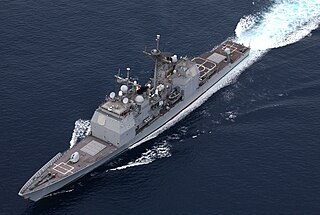
The Aegis Combat System is an American integrated naval weapons system, which uses computers and radars to track and guide weapons to destroy enemy targets. It was developed by the Missile and Surface Radar Division of RCA, and it is now produced by Lockheed Martin.

The Spruance-class destroyer was developed by the United States to replace the many World War II–built Allen M. Sumner- and Gearing-class destroyers, and was the primary destroyer built for the United States Navy during the 1970s and 1980s. It was named in honor of U.S. Navy Admiral Raymond A. Spruance, who successfully led major naval battles in the Asiatic-Pacific Theater during World War II such as the Battle of Midway and the Battle of the Philippine Sea.
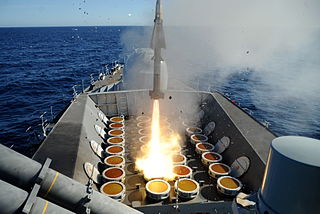
Sea Wolf is a naval surface-to-air missile system designed and built by BAC, later to become British Aerospace (BAe) Dynamics, and now MBDA. It is an automated point-defence weapon system designed as a short-range defence against both sea-skimming and high angle anti-ship missiles and aircraft. The Royal Navy has fielded two versions, the GWS-25 Conventionally Launched Sea Wolf (CLSW) and the GWS-26 Vertically Launched Sea Wolf (VLSW) forms. In Royal Navy service Sea Wolf is being replaced by Sea Ceptor.

A vertical launching system (VLS) is an advanced system for holding and firing missiles on mobile naval platforms, such as surface ships and submarines. Each vertical launch system consists of a number of cells, which can hold one or more missiles ready for firing. Typically, each cell can hold a number of different types of missiles, allowing the ship flexibility to load the best set for any given mission. Further, when new missiles are developed, they are typically fitted to the existing vertical launch systems of that nation, allowing existing ships to use new types of missiles without expensive rework. When the command is given, the missile flies straight up far enough to clear the cell and the ship, then turns onto the desired course.

The Ticonderoga class of guided-missile cruisers is a class of warships of the United States Navy, first ordered and authorized in the 1978 fiscal year. It was originally planned as a class of destroyers. However, the increased combat capability offered by the Aegis Combat System and the passive phased array AN/SPY-1 radar, together with the capability of operating as a flagship, were used to justify the change of the classification from DDG to CG shortly before the keels were laid down for Ticonderoga and Yorktown.
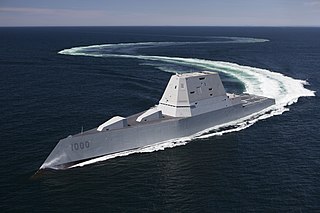
The Zumwalt-class destroyer is a class of three United States Navy guided-missile destroyers designed as multi-mission stealth ships with a focus on land attack. The class was designed with a primary role of naval gunfire support and secondary roles of surface warfare and anti-aircraft warfare. The class design emerged from the DD-21 "land attack destroyer" program as "DD(X)" and was intended to take the role of battleships in meeting a congressional mandate for naval fire support. The ship is designed around its two Advanced Gun Systems (AGS), turrets with 920 round magazines, and unique Long Range Land Attack Projectile (LRLAP) ammunition. LRLAP procurement was canceled, rendering the guns unusable, so the Navy re-purposed the ships for surface warfare. Starting in 2023, the Navy will remove the AGS from the ships and replace them with hypersonic missiles.

The RIM-162 Evolved SeaSparrow Missile (ESSM) is a development of the RIM-7 Sea Sparrow missile used to protect ships from attacking missiles and aircraft. ESSM is designed to counter supersonic maneuvering anti-ship missiles. ESSM also has the ability to be "quad-packed" in the Mark 41 Vertical Launch System, allowing up to four ESSMs to be carried in a single cell.

The Hobart class is a ship class of three air warfare destroyers (AWDs) built for the Royal Australian Navy (RAN). Planning for ships to replace the Adelaide-class frigates and restore the capability last exhibited by the Perth-class destroyers began by 2000, initially under acquisition project SEA 1400, which was re-designated SEA 4000. Although the designation "Air Warfare Destroyer" is used to describe ships dedicated to the defence of a naval force from aircraft and missile attack, the destroyers are expected to also operate in anti-surface, anti-submarine, and naval gunfire support roles.

The Sejong the Great-class destroyers, also known as KDX-III, are three guided-missile destroyers of the Republic of Korea Navy (ROKN).

The Royal Saudi Navy or Royal Saudi Naval Forces, is the maritime arm of the Saudi Arabian Armed Forces and one of the five service branches of the Ministry of Defense of Saudi Arabia. Its primary role is monitoring and defending the Saudi territorial waters against military or economic intrusion, and participating in international naval alliances.

SC-21 was a research and development program started in 1994 intended to design land attack ships for the United States Navy. A wide variety of designs were created and extensively examined, including an arsenal ship with 500 cruise missiles. Eventually a "tumblehome" design of around 16,000 tons with two long-range guns and 128 missile tubes was selected as the DD-21, the Destroyer for the 21st century. The program ended in November 2001.

The RIM-66 Standard MR (SM-1MR/SM-2MR) is a medium-range surface-to-air missile (SAM), with a secondary role as an anti-ship missile, developed for the United States Navy (USN). A member of the Standard Missile family of weapons, the SM-1 was developed as a replacement for the RIM-2 Terrier and RIM-24 Tartar that were deployed in the 1950s on a variety of USN ships. The RIM-67 Standard (SM-1ER/SM-2ER) is an extended range version of this missile with a solid rocket booster stage.

The RIM-67 Standard ER (SM-1ER/SM-2ER) is an extended range surface-to-air missile (SAM) with a secondary anti-ship capability, originally developed for the United States Navy (USN). The RIM-67 was developed as a replacement for the RIM-8 Talos, a 1950s system deployed on a variety of USN ships, and eventually replaced the RIM-2 Terrier as well, since it was of a similar size and fitted existing Terrier launchers and magazines. The RIM-66 Standard MR was essentially the same missile without the booster stage, designed to replace the RIM-24 Tartar. The RIM-66/67 series thus became the US Navy's universal SAM system, hence the designation "Standard Missile".

The Freedom class is one of two classes of the littoral combat ship program, built for the United States Navy.
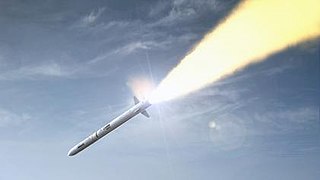
The CAMM is a family of surface-to-air missiles developed by MBDA UK for the United Kingdom. CAMM is derived from, and shares some common features and components with, the Advanced Short Range Air-to-Air Missile (ASRAAM), but with updated electronics, a soft vertical launch system, and an active radar homing seeker. The CAMM family is either currently in-use or has been ordered by ten nations.

The AN/SPY-1 is a United States Navy 3D radar system manufactured by Lockheed Martin. The array is a passive electronically scanned system and a key component of the Aegis Combat System. The system is computer controlled and uses four complementary antennas to provide 360-degree coverage. The system was first installed in 1973 on USS Norton Sound and entered active service in 1983 as the SPY-1A on USS Ticonderoga. The -1A was installed on ships up to CG-58, with the -1B upgrade first installed on USS Princeton in 1986. The upgraded -1B(V) was retrofitted to existing ships from CG-59 up to the last, USS Port Royal.

Yinchuan (175) is a Type 052D destroyer of the People's Liberation Army Navy. She was commissioned on 12 July 2016.

The DDG(X) or Next-Generation Guided-Missile Destroyer program of the United States Navy aims to develop a class of surface combatants to succeed 22 Flight II Ticonderoga-class cruisers and 28 Flight I/II Arleigh Burke-class destroyers. The program is the culmination of the Large Surface Combatant (LSC) initiative that followed the cancellation of CG(X) and curtailing of the procurement of the Zumwalt-class destroyers. The ships will become the principal large surface combatants of the U.S. Navy. Compared to their predecessors, they will incorporate more powerful sensors and have more room and weight margin for growth.


